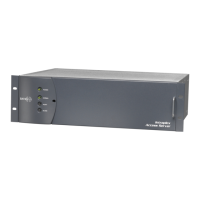6-Testing & Troubleshooting ACS-160 Series & STL-160 Series T1 Mux Installation & Operation
Version 2.11, August 2011
Harris Corporation 6-5
Intraplex Products
2. Press down on the SET/NEXT switch one or more times to display the desired loopback function.
The green (top) section of the bi-level light next to the FUNCTION display turns on if the displayed
loopback is active. The red (bottom) section turns on if it is not.
3. To change the state of the displayed loopback, press up twice on the SET/NEXT switch. The bi-
level light changes state to indicate that the desired setup change has taken place. This is a
toggle-type function. If the displayed loopback is off, pressing up twice on the SET/NEXT switch
turns it on. If the displayed loopback is on, pressing up twice on the SET/NEXT switch turns it off.
4. If you do not want to change the state of the displayed loopback, press down on the SET/NEXT
switch to display a different loopback, or press up or down on the GROUP switch to leave the LPBK
group altogether.
6.3.2 Blinking Indicator Lights (BLNK Group)
The BLNK group gives messages that help explain what is happening when the receive input (RX IN)
indicator lights or any of the CM-5RB timing indicator lights are blinking (Table 6-3). For example, if a
CM-5RB receiver detects an all ones signal, its RX IN indicator blinks, and Rx11 appears in its BLNK
group.
Messages appear in the BLNK group only when they are applicable. When no lights are blinking, the
BLNK group is empty.
Table 6-3. BLNK Group
Message Description
Ftim Fallback timing – One of the timing lights is blinking, indicating that the CM-5RB transmitter is in
its fallback internal timing mode. A timing light blinks when the CM-5RB module is configured to
operate in the looped, through, or external timing modes but cannot do so, generally because of a
T1 facility, CM-5RB module, or external timing source failure. The INT indicator light stays on
continuously while the module is in the fallback internal timing mode.
NLLB Network is requesting a line loopback.
NPLB Network is requesting a payload loopback.
RxYI Receive Yellow Alarm – The CM-5RB receiver detects a Remote Alarm Indication (RAI), indicating
that the far-end shelf has lost the incoming signal and is experiencing a loss of frame condition.
Rx11 Receive all ones – The CM-5RB receiver detects a framed or unframed all ones signal, which might
indicate that the far end shelf is idle or set to equipment loopback. An AIS usually suggests that
there is a transmission interruption at the device generating the AIS or further up the network. An
unframed all ones is a T1 alarm indication signal (AIS).
Rx11 also appears when the T1 carries payload that consists of nearly all ones; specifically, when
there are fewer than three zeroes in two consecutive T1 frames.
Tx11 Transmit AIS – Alarm indication signal—transmit unframed, all-ones signal. Also indicates that this
shelf is in Line Loopback.
TxYl Transmit yellow alarm – Yellow alarm or Remote Alarm Indication (RAI) is transmitted when the
shelf has lost the incoming signal and is experiencing a loss of frame condition. Transmit zeros in
Bit 2 of all time slots.
XsJt Excess jitter – XsJt appears in the BLNK group when the CM-5RB T1 receiver jitter buffer has
overflowed. This normally indicates that the received T1 signal contains excessive timing jitter.
If an indicator light on the CM-5RB module is blinking, perform these steps to determine the cause(s):
1. Press up or down on the GROUP switch until the display reads BLNK.
2. Press down on the SET/NEXT switch to display the BLNK group contents. If there is more than one
BLNK group item, press down on the SET/NEXT switch repeatedly to cycle through the items.
3. To leave the BLNK group, press up or down on the GROUP switch.

